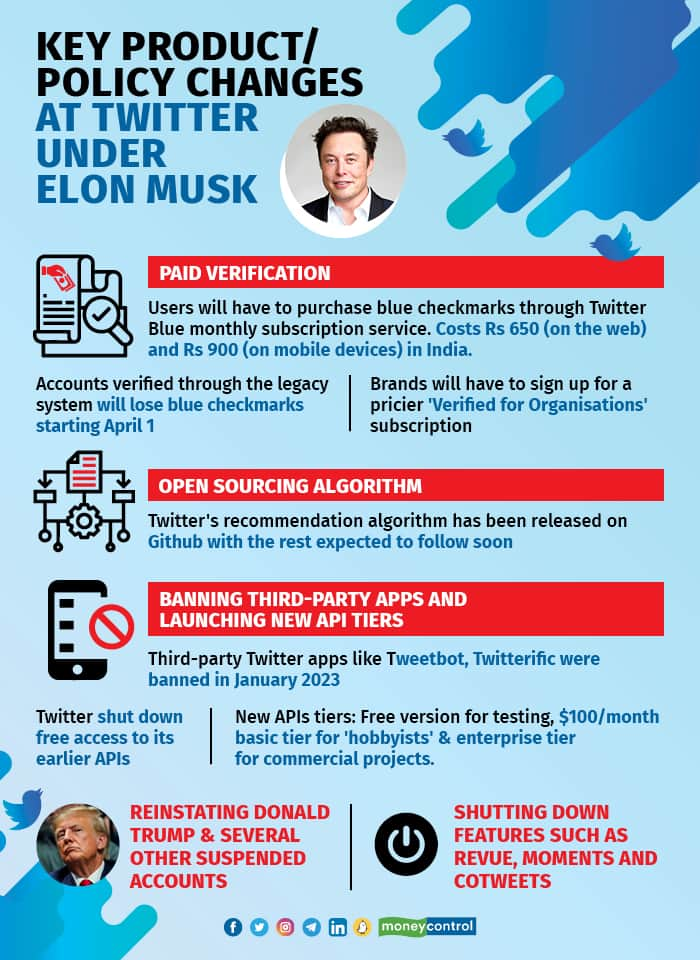



April 4, 2023 marks exactly a year since Tesla chief executive Elon Musk first disclosed his stake in social media platform Twitter, which made him the company's largest individual shareholder at the time.
The move eventually culminated in the mercurial tech billionaire buying the social media company in a $44 billion deal on October 28, 2022, after many dramatic twists and turns -- right from legal challenges to public spats to disparaging memes and the threat of a courtroom trial – all of which lasted for months.
The chaos didn't end there. After taking over the firm, Musk has completely changed how Twitter operates and drastically cut the company's costs, including reducing its workforce by about 75 percent, pushing out the top management, emptying out offices, slashing its cloud costs, cutting down employee benefits and stopping vendor payments, among others.
On April 4, Twitter changed its iconic logo of the blue bird, called Larry Bird, on its web application to "doge", the Shiba Inu dog meme linked to the dogecoin cryptocurrency.
Musk has publicly endorsed dogecoin many times in the past as well.
In recent months, Musk has also made or announced several product and policy changes that are dramatically reshaping how the social media platform works. Here are some of the key announcements made so far:
Paid verification programmeOne of the biggest changes announced by Musk is the option for people to buy a blue checkmark, once denoting notable and authentic users on Twitter, through the company's $8 monthly subscription service Twitter Blue.
This was in complete contrast to Twitter's earlier account verification system, under which it used to give blue check marks to accounts it determined were authentic and in public interest for free.
Apart from the check mark, Blue subscribers could also access a host of other features, like the ability to edit tweets, and post long tweets of up to 4,000 characters.
Soon, Twitter Blue subscribers will also see 50 percent fewer ads in their home timeline and their tweets will be prioritised in conversations they participate in and the search functionality, the company states.
That said, Twitter does not verify the identities of individuals who register for the service. This led to a wave of people creating new paid blue tick accounts impersonating high-profile individuals and brands when the new avatar of Twitter Blue was introduced on November 9, 2022, forcing the company to halt the rollout after just two days.
Twitter relaunched the Blue subscription on December 12, 2022. This time, Twitter said company's employees will verify accounts before granting checkmarks, and only those accounts meeting the company’s conditions would be eligible.
On March 24, Twitter announced that it will be removing blue checkmarks of previously verified accounts of users who do not sign up for Twitter Blue, starting April 1, 2023, as the company winds down its legacy verified programme in a subscription push.
This service, for individuals, is available in India for a monthly fee of Rs 650 on the Web and Rs 900 on mobile devices.
Brands and organisations will have to sign up for a significantly pricier 'Verified for Organisations' programme, whose subscription starts at $1,000 per month. These accounts will receive a gold checkmark and a square avatar. In India, the service is priced at Rs 82,300 per month.
Organisations can also choose to affiliate an individual or entity associated with them for an additional $50 per month (Rs 4,120 per month) per affiliate account.
An affiliate account receives the verification mark as well as an affiliate badge (a small image of the parent company's profile picture) displayed next to the checkmark.
To further grow the service, Twitter is bringing in several features which were previously available for free, under the Twitter Blue subscription. They include being eligible for recommendation in the company's algorithmic 'For You' timeline, SMS-based two-factor authentication, and the ability to vote in polls, among others.
The company has also stopped distinguishing accounts that were verified through its old verification system and those that pay for Twitter Blue.
 A look at key product and policy changes at TwitterCelebrities, organisations choose to not subscribe
A look at key product and policy changes at TwitterCelebrities, organisations choose to not subscribeMost of the previously verified accounts are yet to lose the blue checkmark, as of April 4, 2023. In a now-deleted tweet, Musk said, on April 2, that Twitter would give verified accounts a "few weeks grace". However, Twitter has removed the verified badge of the main account of The New York Times, after the newspaper said it would not pay for the service.
Several users with millions of followers, including the Biden administration and celebrities such as LeBron James, and William Shatner, have said they won't pay for Twitter Blue to retain their blue check mark.
Twitter Blue is one of the company's key initiatives to diversify its revenue streams beyond advertising and is crucial for its future revenue growth as Musk looks to turn around the fortunes of the debt-laden company.
Open sourcing recommendation algorithmTwitter released a portion of its source code on GitHub on April 1, delivering on Musk's long-due promise. The Twitter owner said this includes most of the company's recommendation algorithm, with the rest expected to follow soon. He also mentioned that Twitter will be updating its recommendation algorithm, based on user suggestions every 24-48 hours.
The source code breaks down the algorithm Twitter uses to determine the tweets chosen to appear in the platform's algorithmic 'For You' timeline and how it ranks and filters them. It also tracks the metrics for four key groups: power users, US Republicans, US Democrats and Elon Musk himself.
Banning third-party apps and launching new API tiersFor more than 15 years, third-party Twitter apps, such as Twitterific, Tweetbot, and Fenix, had played a key role in making Twitter the platform we know today, often innovating on new features which were lacking on the platform. Many of these features were later adopted by Twitter on its official apps.
However, these apps faced a sudden demise in January 2023, when they stopped working altogether, with no explanation or communication provided to developers. Nearly a week later, Twitter silently updated its developer rules to ban third-party clients.
The social media firm also announced in February 2023 that it will stop free access to its APIs, ending support for both legacy version 1.1 and the new version 2 of its Twitter APIs, and introducing a paid version instead.
After an intense developer backlash, Musk announced that Twitter will offer a free tier for accounts offering "good content for free."
On March 30, Twitter announced it will offer three new API tiers: a free tier, only for testing purposes, a basic tier for "hobbyists or prototypes" that will cost $100 per month, and an enterprise tier for businesses and commercial projects that will reportedly cost $42,000 per month. The older APIs will be deprecated over the next 30 days, the company said.
Reinstating Donald TrumpTwitter reinstated the account of former US president Donald Trump in November 2022, after Musk conducted a poll on the social media platform. Trump's account was banned in January 2021, after the mob attack on the US Capitol. That said, Trump has not posted any tweets after his account was reinstated.
In subsequent months, Twitter has also reinstated several accounts that were previously suspended. In February 2023, it started allowing all suspended accounts to submit an appeal for reinstatement.
The company said it will take “less severe actions” against accounts that are breaking its rules. Account suspensions will be reserved for severe or ongoing, repeat violations of its policies, it said.
A month later, Twitter also introduced new changes to its Violent Speech policy, prohibiting users from expressing "wishes or desire for harm". They include, but are not limited to, "hoping for others to die, suffer illnesses, tragic incidents, or experience other physically harmful consequences,” it said.
Ad revenue share with Blue subscribers?On February 3, Musk announced that Twitter would share advertising revenues with creators for ads that appear in their reply threads starting that day, provided that the creator is a Twitter Blue subscriber.
However, the company is yet to roll out this feature or share further information on how it would work.
Reversing policies & shutting down featuresOn December 18, 2022, amidst the FIFA World Cup final match, Twitter introduced a new policy that prevented users from promoting their presence and links from other social media platforms, such as Facebook, Instagram, and Mastodon, as well link-in-bio tools such as Linktree.
Accounts created solely to promote rival platforms would be removed, it said. However, following a massive pushback, Twitter reversed this decision on December 19, with an apology from Musk.
This was days after Twitter suspended several high-profile users, including prominent journalists, with Musk alleging that they "doxxed" his location. Twitter also introduced a policy that suspended accounts if they shared another person’s “live location” on December 14. These suspensions were, however, removed shortly.
In January 2023, Twitter shut down its newsletter platform Revue as well as an experimental feature that let two people author a tweet called CoTweets.
The company also shut down its Moments feature that allowed users to curate a collection of tweets in December 2022 and removed the feature that displayed which device a tweet was sent from in November 2022.
Other noteworthy mentionsTwitter extended Community Notes (previously Birdwatch), a crowdsourced feature to fact-check tweets introduced in 2021, to all users across the world in December 2022. Contributors, who are part of the programme, can add contextual notes to potentially misleading tweets. People can see and rate these notes if they find it "helpful".
In the past few months, the company has started admitting contributors from countries such as the UK, Canada, Ireland, Australia, New Zealand, Brazil, and Japan.
The company also started displaying view counts for tweets on iOS and Android in December 2022, which will tell users the reach of their tweets and those they see on their timeline. The feature was subsequently extended to the Web version.
Discover the latest Business News, Sensex, and Nifty updates. Obtain Personal Finance insights, tax queries, and expert opinions on Moneycontrol or download the Moneycontrol App to stay updated!
Find the best of Al News in one place, specially curated for you every weekend.
Stay on top of the latest tech trends and biggest startup news.